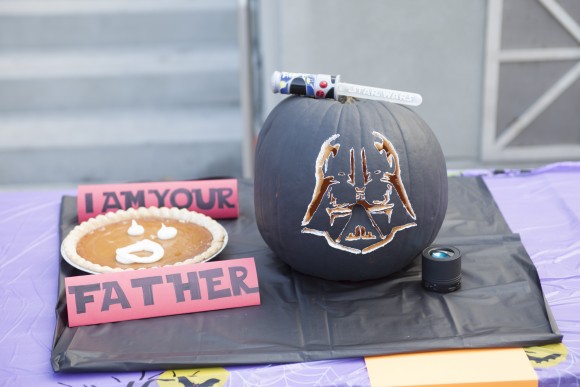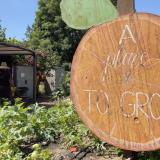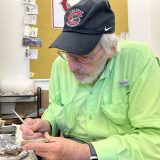In Defense of Pumpkin Spice One of the most hotly debated flavor crazes of the past several years deserves a good scientific defense.
October 26, 2015
With the fall season officially in full swing, we decided to ask Alexa Sarcona, a Food Science student, about some of the science behind pumpkins and specifically, pumpkin spice.
For those that do not live in Southern California, October means cable-knit sweaters, scarfs, and leaves turning orange. But how does one tell in areas without seasons that autumn has begun? Simple. Pumpkin spice flavored
everything
. Instead of leaves turning orange, entire grocery store shelves turn orange with seasonal products anticipating the essential Thanksgiving dessert: pumpkin pie. The question is no longer
should
this be made to be pumpkin spice flavored, the question is
can
it be made into pumpkin spice flavored, and the answer is always yes. There are pumpkin spice flavored cream cheeses, cookies, cereals, breads, chips, marshmallows, yogurt, and the famous pumpkin spice latte. The flavor combination has also infiltrated the restaurant business as well, where creations like a pumpkin spice fried chicken doughnut sandwich, slathered with pumpkin spice aioli are served.

In recent years, consumers have begun to question what ingredients are in their food. It was only a matter of time before the beloved pumpkin spice flavoring was questioned. It should be simple, right? Add some pumpkin, some sugar, some spices, and hope for something that tastes like a pumpkin pie? Not exactly.
As it turns out, pumpkin spice is a carefully engineered flavor that doesn’t contain any pumpkin because it doesn’t need to. This is a relief considering the current lack of pumpkins in California due to the historic drought and uncharacteristically hot summer happening. This lethal combination has stunted the growth of the pumpkins that did not rot and collapse from the heat, leaving the top pumpkin growers in California mourning fields of withered and rotted pumpkins.
Luckily, even in times of drought, consumers can still get their pumpkin spice fix because the flavor can be achieved without any actual pumpkin. The goal is to recreate the flavor of a Thanksgiving pumpkin pie in something that is not a pie. The flavor is all about the spices typically used in a pumpkin pie, like cinnamon, allspice, clove, nutmeg, ginger, and vanilla. The flavor of pumpkin just is not strong enough to compete with these spices and goes unnoticed. The signature taste of pumpkin pie can be attributed to the heat from baking the pie which causes new flavor compounds to occur in the pie that don’t exist in these spices before baking, creating the signature spice flavor associated with pumpkin pie.
There are approximately 340 flavor compounds in the traditional mix of pumpkin spice, but scientists only use key flavor compounds of the spices to create a recognizable pumpkin spice flavor. For example, cinnamic aldehyde is commonly used for cinnamon flavor. Eugenol replicates the flavor and aroma for allspice and clove. Turpenes like sabinene for nutmeg, zingiberene for ginger, and vanillin for vanilla. Each of the ingredients listed above is Generally Recognized as Safe (GRAS) by the FDA as well as Flavor & Extract Manufacturers Association (FEMA) for use as a food flavoring.
Of course, the whole spice could be used instead of their isolated flavor compounds, but the flavor created would be different than the expected pumpkin spice. It would be more like chai tea than pumpkin pie. Additionally, the price of the product would most likely increase, as companies would have to purchase imported spices rather than their synthesized flavor compounds. This would also increase the environmental impact by drastically increasing demand for these spices, so it would require an increase in finite resources like land and water. The spices needed are mainly sourced from Asian and African countries, further contributing to pollution from international transportation to North American companies, where the demand for pumpkin spice flavoring is most popular. India and Thailand are major producers of ginger, Indonesia and Madagascar are major producers of vanilla, and Sri Lanka is a major producer of cinnamon. It might surprise you to know that none of the spices essential to the taste of a classic Thanksgiving pumpkin pie are sourced from North America.
Using the flavor compounds saves resources, decreases pollution from trade, and reduces demand. Each flavor compound can be extracted from multiple sources or synthesized using multiple methods and reactants in labs. Without the help of these synthesized flavor compounds, it is questionable if the world spice supply could meet the demand of American consumers. Of course, the choice is ultimately up to the consumer on how they want their pumpkin spice products made. The main differences between the two is that conventionally manufactured pumpkin spice flavor will have the flavor most similar to a Thanksgiving pumpkin pie and it will have a smaller impact on the environment, while using the traditional form of spices will not.


